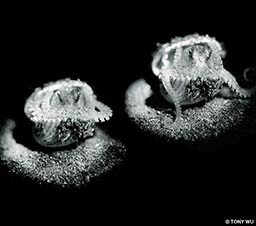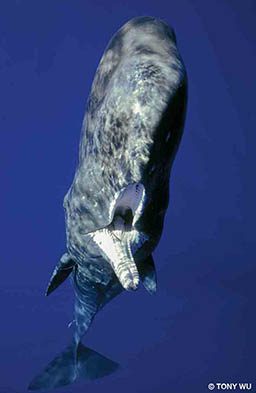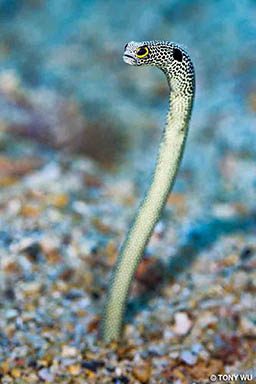
When I interview underwater photographers with a critical mass of truly significant images, such as the ones who are profiled here in our Shooter column, quite often an experiential commonality has set them down their path. If they are of a certain age they probably had their first inspiration while watching Sea Hunt or The Undersea World of Jacques Cousteau on television. Perhaps they lived near the sea, or maybe their parents took them to the ocean on family holidays. But I discovered that Tony Wu, a three-time winner of the Natural History Museum’s highly prestigious Wildlife Photographer of the Year, was not influenced by any of these factors.
In fact, the obvious question that begins most interviews — “Where are you from?” — turned out to be the most ambiguous.
TONY WU: “Where are you from?” is a reasonable question, but for me there is not an easy answer. I’m home wherever I am, and I’m in a different place all the time. I suppose you are asking where I grew up as a child. I never really had one place to call home. I moved around constantly. In the beginning it was a byproduct of family circumstances over which I had no control. After leaving home, I just kept going. It’s been my lifelong reality.
I moved to the USA when I was just a few years old. English was my third language. I struggled a lot in the beginning, being a tiny Asian kid without any foundation in the culture. Imagine being plunked into an elementary school in Detroit, Michigan, unable to speak English, surrounded by kids who looked different and were much, much bigger than I was. I needed to fit in, but I didn’t. Perhaps because I had to struggle to comprehend every word, I noticed that many people seemed to talk just to fill the air with sound. I had to tune out the noise to learn to communicate in an unfamiliar language and ever-changing settings. As a result, I’m not good with small talk, but if I meet someone who is truly interesting and sincere then I enjoy having a deep conversation because it is a wonderful way to learn.
East Asian families tend to prioritize education, so I later attended private school. I had no problem with science and math because these skills were language independent, but English remained difficult for many years. I worked on my language skills in part by watching the evening news. People such as Walter Cronkite were my tutors for vocabulary and enunciation, but it wasn’t until much later in life that I became confident with the language.
Why do I have such an affinity to the sea? At various times while I was growing up, I found myself in coastal areas. I was drawn to the ocean and its inhabitants, often losing myself for entire days while scouring beaches and exploring tide pools. But really, it’s sort of like asking why I breathe. I just do.

It’s not just the sea though. I love all nature. For example, I recently visited Kyoto with my wife. When I first visited the historic area back in the 1980s, the temples were magical — aesthetically pleasing oases of serenity. How things have changed. Every major temple and shrine we tried to visit was inundated with busloads of tourists arguing, littering and shoving each other aside for the perfect selfie. The level of disrespect and narcissism was beyond belief. Saddened by the spectacle, we walked off on a random path, found a small stream and sat down. We watched insects go about their business, marveled at the intricacy of moss, listened to the sound of rustling leaves and water slipping over stones. Hours passed. What started as a nightmare of noise and chaos turned out to be a beautiful day of tranquility and contemplation, thanks to Mother Nature.
STEPHEN FRINK: Speaking of paths as allegory, tell me about the fork in the road of your life. I watched a Japanese television special about you that mentioned you were a banker. What transitioned you away from finance to wildlife photography?
TW: I can’t say banking was ever really what I wanted to do. I left home shortly after turning 17 and was just shy of penniless for many years. I needed to climb out of poverty, and banking was a quick way to do it. Finance took me to many countries and gave me a front-row view of much of how the world works. At various times, I was based in New York, Tokyo, Hong Kong, Bangkok and Singapore, among other places. But the thing about international finance is that even when you live somewhere, travel is normal. Much of the time I was in two or three different countries a week. Banking was never going to be my lifelong occupation, although I found it intellectually stimulating, particularly in the way finance interweaves with politics and global affairs.
SF: Was there one single event that was transformational for you — the thing that told you being a marine photographer was your calling?
TW: Perhaps not a defining moment, but I guess the most memorable was my first underwater encounter with a sperm whale, in Japan in 2000.
Sperm whales are giant carnivorous animals, and the last words from the boat captain before I jumped in were, “If it hits you with sonar, it might think you’re food!” As luck would have it, the whale hit me with sonar — very loud sonar — almost immediately, and I thought I was whale food. There wasn’t a lot of information available at the time about spending time in the water with sperm whales, so my mind was filled with apprehension.
Being pummeled with sonar caused me mild panic, but I really began to worry when the whale planted me on its head. The whale took my fin in its mouth. At that point, I almost crapped my pants.

I’m still here to tell the story, so the whale clearly did not harm me. In fact, though it took some time and a leap of faith, we became friends — really good friends. We spent more than three hours together. Everywhere I went, the whale followed. Every time I surfaced to reload film, the whale waited at the stern of the boat until I dropped back into the water. The whale seemed to not want the encounter to end.
Once my fear decreased, my brain became receptive, and I picked up on nonverbal communication from the whale. That’s how we ended up interacting for many hours. That was my epiphany, concluding that almost every impression I had about sperm whales was wrong. Whales are not lumbering beasts; they are inquisitive, introspective, gentle, nuanced animals that think and feel just as we do. If the common view of whales could be so wrong, I realized, what else should I question? The answer, of course, is everything.
SF: Were you an experienced underwater photographer at the time?
TW: No, I started shooting in 1995 with a Nikon F90 film camera. My first photos were so bad that I was totally convinced there was something wrong with the camera. In hindsight, I wish I had kept some of those first frames of slide film. They’d be great for a laugh.
In the early days I went diving as often as possible, shooting everything I could. I started exploring the rich waters of Indonesia long before it was popular, photographing mostly macro stuff. I took notes for all my photos, writing down my settings and any relevant information for all 36 shots per roll of film. When the film came back from the lab, I looked through what I wrote and tried to figure out what I did right — or at the time, mostly wrong. It was an expensive, time-consuming process, but that’s how I learned.
I also spent a lot of time researching and trying to learn about the animals I photographed. Research is easy these days, with many identification books and online resources available, but in the 1990s, not so much. I started to write columns for magazines, often about marine life and the things I learned through research and observation. By 2001 I had published a coffee-table book called Silent Symphony, which won the books category at the World Festival of Underwater Pictures in Antibes, France.
SF: I had the impression from the television interview, reinforced here, that you are a deeply introspective person. Do you have a philosophy that guides you?
TW: Carpe diem. We have only so many days in life. At some point I realized that I had a choice of how I spend those days. I could continue to devote 16 to 18 hours every day of the year to work, going from one emergency to the next on behalf of this company or that, or I could stop and seize control. So I did. These days I travel about 10 months a year, much of that time with my wife and often in the company of great friends. I research and think about new projects all day every day. I spend time reflecting upon the things I experience and try my best to learn and improve. Even if all my photos were to disappear, I have had unique, meaningful adventures, experiences and friendships that I wouldn’t trade for anything.

SF: Are you a camera technology aficionado, always using the best and newest?
TW: Not really. Cameras these days are so sophisticated that they can do far more than I usually need, but each make and model has strengths and weaknesses. I identify what I want or need to do, then I try to find the best match with what’s available. Sometimes it’s the newest, latest and greatest, but not always.

For the past several years I have been using Canon, Sony and Nikon cameras. Not being wedded to a single brand has its downsides, namely expense. But being fluent in three systems gives me enormous flexibility as well as a reasonably objective view of relative pros and cons.
I currently have a Nikon D800 and D850, which have wonderful dynamic range and produce beautiful results when paired with the 60mm and 105mm Micro-Nikkor lenses. I’ve relied on Canon DSLRs for most of my bluewater open-ocean photography and telephoto images above water, while I use my Sony 7r-series cameras mostly as manual cameras for the excellent sensors and adaptability to use just about any available lens. They are all different tools for different purposes, and they are all great cameras. I currently use housings made by Zillion and Nauticam; both companies have been supportive of my oddball ideas and projects over the years.

SF: You are particularly well known for your work with humpback whales in Tonga. It seems you go back year after year in season. How did that come about?
TW: I first tried to photograph humpback whales in Tonga in 1998. I failed miserably then and two more times subsequently.
These days it’s easy to show up and have everything done for you by boat operators there. Back then I had to figure it out. It took some time to learn the behavior, to understand the patterns of movement, to “get” the body language.
The more I learned, the better my photos became, but also the more interesting the whales became. To give you one example, since 1998 I’ve tracked a particular female’s visits to the area and the calves she had there (with the help of many generous people who’ve contributed sighting data). This female had calves in 1999, 2002, 2006, 2008, 2009, 2012, 2014 and 2016. Having this information, backed up by photos and video, I’ve been able to illustrate a substantial portion of this female’s life history. It also gives me something to look forward to: spotting her with her next baby. I keep going back because of the many things I have learned and can continue to learn.
SF: How do you decide which photo opportunities will be solo adventures and which will be photo tours that you share with select guests?
TW: I undertake a lot of solo projects, as not all places, animals and situations are conducive to having multiple people in the water. Most people don’t want to wait for weeks in a remote location for something that they hope will happen but could very well not. Some behavior happens only when there is minimal disturbance, and that condition could easily be disrupted.
But if I think there is a possibility of eventually running a trip as a guided tour, I’ll usually go by myself first. If you run a trip, you should be familiar with the relevant details.
For example, I spent a lot of time and money on humpback whales long before I ever thought about having other people join me. I failed and failed again. I learned through experience and study so that by the time I asked people to travel with me, I was able to help guests have the best experiences possible and understand the natural-history context of what they saw.
As a result, the majority of people I’ve traveled with have become great friends; they are keen on learning and fully appreciating how fortunate we are to have encounters with wild animals in the water.
The type of people I do not want on trips are ego-tourists: those whose primary motivation appears to be posting to social media without due consideration of the welfare of the animals and environments concerned.

A recent example involved sperm whales in Sri Lanka. I watched as multiple speedboats chased and cut off a social unit of sperm whales each time the cetaceans surfaced. The reason? The many camera-laden underwater photographers absolutely had to get photos to post to Facebook, Instagram and the like. It was clear that they did not understand why the whales were surfacing, and they likely did not care. Most were also incapable of swimming and had to be placed directly near the whales. As a result, the boats chased and repeatedly drove over the whales.
I asked my friends to watch how many breaths the whales could take when being chased — they counted 10 breaths on average. We motored many kilometers away to where I thought the whales might go next to escape the armada. When the whales surfaced to breathe, there were no other boats nearby.
Once again, I asked my friends to count the number of breaths the whales took this time without tourist photographers around to force the whales down. The first whale to surface took 54 breaths before diving — 54 instead of 10. That is harassment by underwater photographers and their trip leaders. I understand it is easy to be overwhelmed by the moment. The people who choose to travel with me want the photo opportunities, of course, but I think they also want to learn what I’ve learned over the years about how to approach marine life. Our goal is to be allowed into their space, accepted and then rewarded with the proximity that underwater photography requires.
Explore More
| © Alert Diver — Q2 2018 |